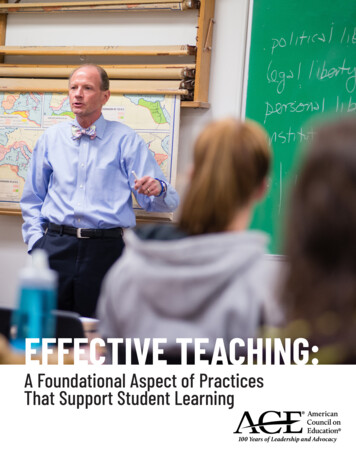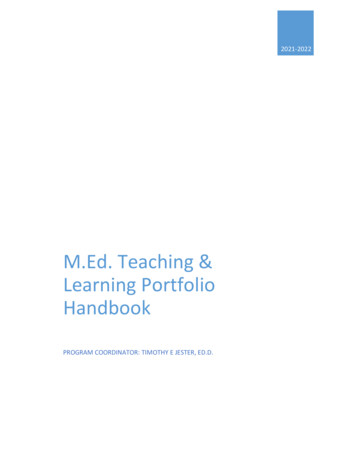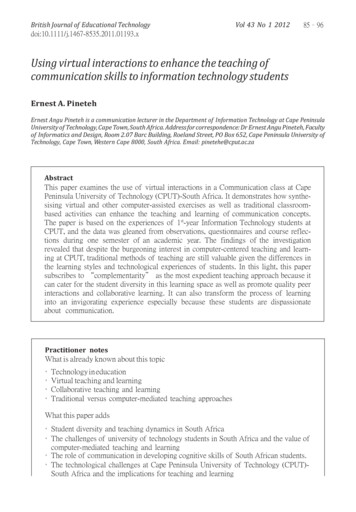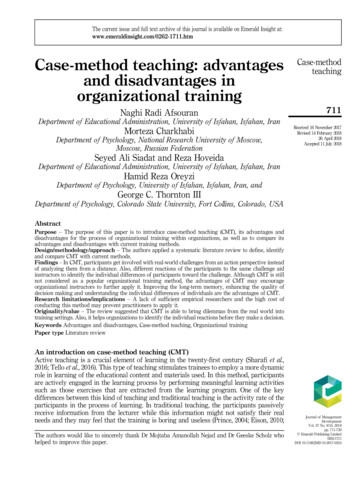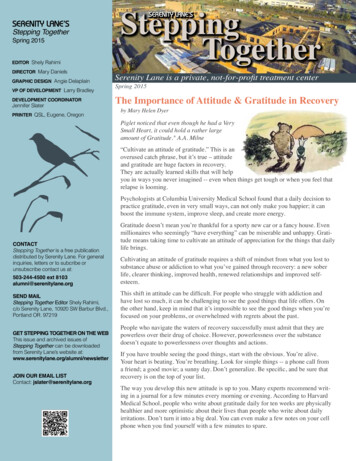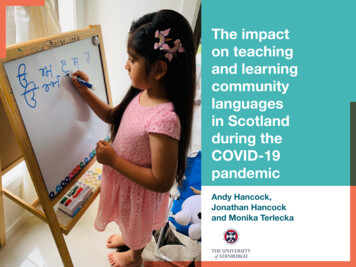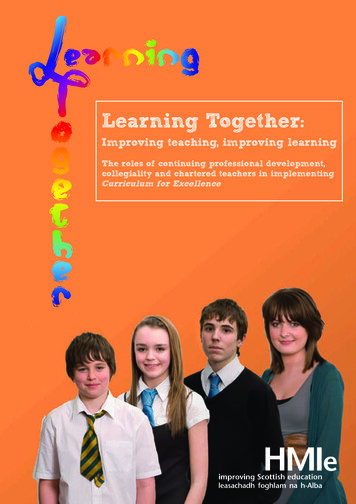
Transcription
Learning Together:Improving teaching, improving learningThe roles of continuing professional development,collegiality and chartered teachers in implementingCurriculum for Excellence
Learning Together:Improving teaching, improving learningThe roles of continuing professional development,collegiality and chartered teachers in implementingCurriculum for ExcellenceHM Inspectorate of Education, 2009
Crown copyright 2009ISBN: 978-0-7053-1164-9HM Inspectorate of EducationDenholm HouseAlmondvale Business ParkAlmondvale WayLivingstonEH54 6GATel:01506 600 200Fax: 01506 600 337E-mail: enquiries@hmie.gsi.gov.ukProduced for HMIE by RR Donnelley B62037 11/09Published by HMIE, November 2009This material may be copied without further permission by education authorities andeducation institutions in Scotland for use in self-evaluation and planning.The report may be produced in part, except for commercial purposes, or in connectionwith a prospectus or advertisement, provided that the source and date therefore arestated.The text pages of this document are printed on recycled paper and are 100%recyclable.
ContentsPageForeword2Introduction4Continuing Professional Development6The Impact of CPD19Collegiality23Chartered Teachers27Summary of Key Findings311
FOREWORDCurriculum for Excellence sets a rightly-ambitious agenda for reform in Scottisheducation. While Scottish teachers have highly-developed professional skills, thesuccess of the reform will depend upon teachers developing new knowledge,understanding and practice. Particularly in an environment where resources arerestricted, it will be important to use available time and resources to maximum effect toachieve this. The Teachers’ Agreement1 established conditions and processes whichare intended to enhance individual teachers’ professional skills, knowledge andattributes, and provide a context for them to be able to perform to the highest level. Thebenefits of the Teachers’ Agreement have yet to be fully realised. Successfulimplementation of Curriculum for Excellence relies on this.We have reached a transition point in both Curriculum for Excellence and theimplementation of the Teachers’ Agreement. Many of the required components are inplace. The revised Standard for Chartered Teacher2 clarifies what chartered teacherscan be expected to contribute and offers the potential for further improvement.Implementation of Curriculum for Excellence is at the point where there will be asignificant expansion from individual initiatives in selected areas to adoption by allteachers across all aspects of learning. There is a risk that, in the face of thisdemanding agenda and a failure to use available resources to the full, changes may besuperficial. There is a further risk that energies may be directed towards activities whichwill not lead to the outcomes we seek for learners, as summed up in the attributes andcapabilities of the four capacities. Will children and young people gain, for example,deeper conceptual understanding, more developed powers of analysis and morefirmly-established skills in literacy and numeracy? Will they develop attributes such asresilience and discernment more fully?At this transition point, this publication looks at some of the most important factorswhich will be needed for these profound changes. It takes stock of emerging practice inprofessional development and describes how collegiality, the contributions of charteredteachers, partnerships, leadership development, and the potential of information andcommunications technology can help to achieve the challenging outcomes we seek. Itreaffirms the importance of teachers learning together, recognising that the insights andexpertise which lead to improvements for learners are often to be found amongstcolleagues. It contains examples of promising and effective practice and points forfurther engagement and discussion.We hope that this approach will help to improve our collective understanding of whatworks well, enable schools and authorities to address effectively the whole agenda ofprofessional development for Curriculum for Excellence and so help teachers to acquirethe knowledge and skills they will need if Curriculum for Excellence is to reach its fullpotential.1 A Teaching Profession for the 21st Century SEED January 20012 The Standard for Chartered Teacher Scottish Government and GTC Scotland 20092
Our work has shown that high quality professional development, collegiality and thework of chartered teachers are helping many schools in their work towardsimplementing Curriculum for Excellence and that this is already leading to moremotivating experiences for learners. We have found a great deal of encouragingpractice, but this is not in evidence consistently across all schools and educationauthorities, and not all parts of the agenda are yet being systematically addressed.Most importantly, there is not yet a clear enough link between these activities andimprovements in children and young people’s learning.We know that it is the commitment and skill of individual teachers which makes thebiggest difference to children’s progress and achievement. All teachers, therefore, havea responsibility to continue with professional learning throughout their career andfurther develop their knowledge and practice in order to meet the expectations placedupon them by Scottish society. This in turn places responsibilities upon all leaders toensure that all teachers are able to continue their professional development in wayswhich have real impact on children’s learning, and contribute their skills and expertiseboth individually and collectively. It also has implications for all of those who provideeducation for teachers, to ensure that they have access to relevant, high quality supportfor their professional development at all stages of their careers. Finally, it hasimplications for staff across all services for children who have roles in supportingchildren’s learning and development, that they should work together but also learntogether, to enable the whole staff to support the whole child.It is essential that we use our knowledge of efficient and successful approaches toteacher learning as we plan for the continuing professional development of the teachersof Scotland and the implementation of Curriculum for Excellence. Only by ‘learningtogether’ will we all, collectively, achieve its aims. I hope that this publication will help toimprove the quality and impact of continuing professional development, to the benefitof all learners.Graham HC DonaldsonHM Senior Chief Inspector3
IntroductionThis publication forms part of the HMIE Learning Together series, which is based on theprinciple that when teachers learn from and with each other this can lead to betteroutcomes for learners. Its focus is upon continuing professional development (CPD),collegiality and the role of chartered teachers in schools. It draws upon knowledge ofpractice gained from 2007 to 2009, including evidence from our inspection programme,and the findings of research. We visited schools in every education authority and haddiscussions with staff. We reviewed the practices and processes being developed inschools and authorities and identified examples of emerging and innovative practice.Most importantly we sought evidence for the impact of these processes on theoutcomes for learners. We are grateful to the schools and the education authorities forworking with us on this task.Curriculum for Excellence and the Teachers’ AgreementThe ambitious intention of Curriculum for Excellence is to reform both how and whatchildren will learn so that they are equipped to face the major challenges arising fromglobalisation, economic uncertainty and social and technological change. In particular,Curriculum for Excellence aims to raise standards of attainment and also to address theunacceptable gap in the attainment between our highest- and lowest-attaining youngpeople. In line with developments in other parts of the world, the curriculum is beingdefined in ways which require each teacher to engage with principles and relativelybroad descriptions of what children should learn, rather than through highly-specificdescriptors or time allocations.For this approach to be successful, teachers need to understand, in depth, theintentions and expectations of Curriculum for Excellence and to develop their practiceto meet these new and challenging expectations. Curriculum for Excellence hasimplications, for example, for: curriculum design; how knowledge and understandingare developed; how to enable children and young people to develop higher orderthinking skills, and skills for learning, life and work; understanding the relationshipbetween learning and teaching to achieve broader outcomes; understanding ofassessment and assessment practice; partnerships between those who contribute tolearning; and supporting learning and development. The changes all have implicationsfor the range and purposes of CPD and for leadership at all levels. These have beenanalysed by the Curriculum for Excellence Management Board and published as adiscussion paper3.3 Towards a professional development strategy for Curriculum for Excellence: Management Board discussion paper ScottishGovernment 20094
A Teaching Profession for the 21st Century (referred to here as the Teachers’Agreement) was the response of a tri-partite4 implementation group to the McCroneCommittee report5. Amongst other features of the agreement, there are expectations forcontinuing professional development, collegiate working and the role of charteredteachers. The arrangements for professional development, including collegiality, and therole of chartered teachers, need to enable and support the process of change for theimplementation of Curriculum for Excellence. This Learning Together report addresseseach of these aspects.Previous HMIE evaluations of the implementation of the Teachers’ AgreementHMIE carried out evaluative work between 2002 and 2006 on the implementation of theTeachers’ Agreement and published the findings in January 2007 in Teaching Scotland’sChildren6. In that report we said that the extent to which the agreement’s variouscomponents had been put in place successfully was a real achievement for all thoseinvolved. New career structures had broadened the opportunities for teachers in allsectors and at all levels to show collegiality, demonstrate leadership and takeresponsibility for creating a quality of learning fit for the 21st century.While we noted signs of increasing collegiality and evidence of better approaches tocontinuing professional development, we said that implementation of the Teachers’Agreement had yet to improve significantly the learning of children and young people.We also reported that the potential benefits of the new chartered teacher posts werenot being fully realised. Overall, while there were emerging signs of broadening practicein professional development, more sharing of good practice and an increasinglycollegiate atmosphere for improvement, some aspects needed to be improved.More recently, in Improving Scottish Education7 we stressed the importance ofcommitment to personal and professional development on the part of every educator.We said that leaders need to foster a culture in which individuals are part of aprofessional community which takes responsibility for its own learning and makes thebest use of time and expertise inplanning for essential continuingprofessional development, including thesharing of good practice.We hope that the narrative of this reporttogether with the illustrations of practicewill provide a good basis for reflectionand learning, and so contribute to furtherimprovement in both teachers’ andchildren’s learning across all schools andauthorities.4 The group involved representatives from the then Scottish Executive Education Department, COSLA and teachers’ unions5 The Committee of Inquiry into Professional Conditions of Service for Teachers was set up by Scottish Ministers in September1999 and led by Professor Gavin McCrone6 Teaching Scotland’s Children: A Report on Progress in implementing ‘A Teaching Profession for the 21st Century’HMIE January 20077 Improving Scottish Education: A report by HMIE on inspection and review 2005-2008 HMIE 20095
Continuing Professional Development“(Teachers) have a professional commitment to develop their skills andexpertise in classroom practice and other related matters throughan agreed programme of continuing professional development8.”How are CPD needs identified?The CPD needs of teachers are usually identified within school and education authorityquality assurance and improvement planning processes, including professional reviewand development. Needs are generally identified through self-evaluation by individualteachers, and sometimes in response to feedback from learners, peer observers, linemanagers and quality improvement officers. In the best practice, professional reviewand development discussions are also informed by the line manager’s direct knowledgeof the teacher’s strengths and development needs in teaching, gained throughobservation and discussion. The rigour of this process is not yet consistent across allschools and authorities.An inclusive and supportive approach to identifying andmeeting CPD needsSenior promoted staff in this secondary school use the professional reviewand development process to identify thematic and individual needs, bothsubject-specific and generic. Teachers have to make a case for how theprofessional development they wish to engage in will improve their teaching.Discussions with senior staff about the desired CPD are informed by thesenior leader’s direct knowledge of the teacher’s profile of strengths anddevelopment needs in teaching. For example, some teachers who werehaving difficulty in establishing productive classroom relationships undertookanger management or assertive discipline courses, or visits to other classesto see good teaching practice. Some teachers were taking part in a workinggroup, developing aspects of numeracy in their subject areas as a basis forwider dissemination and sharing of learning. The school also uses peerobservation and development work as important components of professionaldevelopment.8 A Teaching Profession for the 21st Century Annex D – Code of Practice on Working Time Arrangements for Teachers ScottishExecutive Education Department 20016
There has been a positive shift towards increased professionalism as teachers areincreasingly identifying their own CPD needs by using non-class-contact time todiscuss and share ideas, experiences and resources with each other. This sharing hasled to an increased sense of common purpose and more collegiate endeavour in manyschools. The identification of CPD needs is seen as an important aspect ofimprovement and not as an expression of weakness. The collegiate approach toidentifying CPD needs encourages engagement and ownership of developments,particularly in relation to implementation of Curriculum for Excellence.School and authority CPD coordinators are effective in collating identified developmentneeds to determine whether these are at individual, departmental, whole-school, clusteror authority levels and plan accordingly.Although we did find some good practice in identifying the training and developmentneeds of support staff9, the CPD needs of teaching staff are identified moresystematically than for other staff.How far are professional review and development processes and other planningarrangements for CPD based upon consideration of the full implications ofCurriculum for Excellence?How effectively are the various competing needs for CPD prioritised andconnected to implementation plans for Curriculum for Excellence?What is the range of CPD opportunities?Teachers are undertaking an increasingly varied range of CPD activities, with a greateremphasis on locally-planned and organised activities and some encouraging signs thatinformation and communications technology (ICT) can play an important role in teacherprofessional development. These changes to the patterns of CPD are important,because the way in which CPD is organised influences its potential to have an impacton children’s learning.There is an increasing emphasis on CPD activities at school, cluster and educationauthority levels. These ‘in-house’ activities draw on existing staff expertise as well asthat of external providers. This locally-based CPD often has considerable impact sinceit can be closely tailored to the needs of individuals and the improvement priorities ofschools and authorities. Essentially it involves teachers in learning together andteaching each other. It can enhance professional competence and confidence amongstthose who lead and support their colleagues in this way. It is often cost-efficient. Bybuilding CPD into each school’s improvement strategy it can also develop sustainedcapacity for improvement.9 In this report we use the term support staff to describe members of staff who have administrative, support and ancillary roles.7
Much CPD relates to priorities which have been identified at education authority level,such as cooperative learning and critical skills, and involve all staff. The approach ofteninvolves central training supplemented by follow-up events and activities at cluster andschool levels. These initiatives often have a significant impact on teachingmethodology. They can also achieve a shared sense of purpose as all teachers areinvolved. Having well-planned arrangements for follow-up activities increases theimpact.Improving quality and working across sectors through systematicprofessional development across an education authorityThis education authority has identified teaching, learning and leadership asits main themes for CPD. CPD systematically covers all staff includingsupport staff and ‘returning teachers’. Approaches include successfulnetworks for chartered teachers, faculty principal teachers, deputeheadteachers, associate assessors, supply teachers and community learningworkers.CPD for Curriculum for Excellence has involved staff from different schoolsand centres working together. Teachers and support staff often learntogether, for example in training sessions on managing challengingbehaviour, and there is often multi-agency joint training. To support thesharing of practice, each school is asked to identify its own good practiceand enable staff to visit other schools.The ‘framework for educational leadership’ provides a basis for progressionthrough four levels – project leadership, team leadership, school leadershipand strategic leadership. Headteachers benefit from well-targeted CPDopportunities including work placements, leading education authorityworking groups and being part of EA teams which review schools.There is increasing use of coaching, mentoring and peer observation in many schools.Teachers support each other and share practice across classes, departments andschools as part of the improvement process. For example, ‘stage partners’ in primaryschools often support newly-qualified teachers or more experienced colleagues whoare transferring to a stage at which they have not taught for some time. Pairing with asmall number of critical friends is an increasingly useful approach. Further advice onthis type of activity can be found in Learning Together: Opening up learning10.108Learning Together: Opening up learning HMIE April 2009
A wide range of CPD includes sharing practiceThe headteacher of this secondary school has vired money from other budgetsto support CPD. Staff are building their knowledge and confidence throughwork with local primary schools on developing learners’ literacy skills and jointtraining with other agencies on the GIRFEC agenda. They are helped to reflecton their teaching and extend their practice through British Council-fundedprojects on learning and teaching with schools in other countries. They havebenefited from visits to other schools to see effective teaching includingapproaches to formative assessment.Staff get together in small groups to reflect on their work and shape theschool’s improvement plan. A significant number of staff have signed up to aninitiative in which teachers organise themselves in groups of three to reviewtheir own practice, observe each other teaching, and provide each other withconstructive feedback.In addition to peer observation and joint work within the cluster, staff areinvolved in shadowing colleagues. Staff in some departments discuss theirwork with colleagues in other schools and countries through on-line groups.Young people feel that staff listen to them more and discuss learning andteaching approaches with them. ICT is being used more effectively to enhanceyoung people’s learning and involve them more effectively. Effective formativeassessment strategies are in use in all classes, helping young people to takemore responsibility for their learning.Many teachers attend external courses andconferences organised, for example, byLearning and Teaching Scotland, professionaland subject associations, the Scottish SchoolsEquipment Research Centre (SSERC) andHMIE. The impact of these depends upon howwell they meet teachers’ identified needs andextend their knowledge, understanding andskills, and then upon teachers applying whatthey have learned and passing this learning onto colleagues in a structured way.There are examples of strong partnershipsbetween universities and education authorities toprovide professional development for teachers.Universities are actively seeking to extendpartnership working with education authorities.Such collaboration has much to offer, bycapitalising on expertise and knowledge ofresearch and practice. Several universities are,however, experiencing a declining demand forCPD from education authorities.9
Examples of partnership activities involving universitiesTeacher fellows undertake one day a week secondments to work inpartnership with initial teacher education tutors and students. There is afocus on the practice-based elements of the Standard for Initial TeacherEducation. There can be direct and immediate links between the theory andprinciples of Curriculum for Excellence and its implementation in schools.The teacher fellows learn from this interaction and are able to contribute theirknowledge to their school’s improvement.University staff are involved in training ‘critical friends’ for teachers and indeveloping the skills of the mentors and regents who work with probationerteachers. This work is enhanced in education authorities where there iseffective coordination within the local authority by an officer appointed tooversee this aspect of the partnership.In addition to courses leading to the Scottish Qualification for Headship,universities have developed leadership programmes which are tailored tomeet the requirements of education authority partners. There arepartnerships for CPD with teaching unions and headteachers’ associations.ICT makes materials for teachers’ professional learning more readily available and alsoenables them to engage in dialogue with others. High quality online resources canprovide an excellent basis for self-directed learning. The increasing use of Glow11, thenational education intranet, to enhance professional development and create onlinelearning communities is encouraging.Some education authorities have established Glow as the main mechanism forcommunicating across the authority and for sharing resources and practice. Some useit to give teachers access to materials and films from CPD activities so that they cancontinue to use them beyond the event itself.With its video contact facilities, Glow can be used to share practice in classrooms.It can enable teachers to come into direct contact with experts through masterclassesand online professional communities. Numbers of national and education authoritynetworks have been established, for example for curriculum areas and subjects, forchartered teachers and for librarians.Teachers themselves arrange meetings and create informal learning communitiesaround a particular interest. Some specific developments, such as games-basedlearning, rely on online communication through Glow to develop thinking, contributeresearch findings and share practice.We also found good practice in using online resources such as HMIE’s Journey toExcellence12 for professional development.111210Scotland’s national intranet for education, funded by the Scottish Government and managed by Learning and Teaching llence/index.asp
Use of Glow for CPD for early years staff and Building the CurriculumPractitioners across a range of early years centres in an education authorityhave participated in joint CPD sessions with a university lecturer, using GlowMeet. During the sessions, which are usually held as twilight sessions, thelecturer gives a presentation to all participants then involves them in follow-upactivities with colleagues in their own establishment and continuing dialogueacross participating establishments. This pilot is being supported by LTS staff.A second education authority, which has decided that Glow will be the maintool for communication between schools, has established a cluster model toprogress the thinking and implementation of Building the Curriculum 3 and,in particular, to ensure smooth transition in learning across transitions. Ineach cluster a secondary DHT and a primary promoted postholder have beengiven some time to coordinate the development. The outcomes of thisdevelopment work will be shared on Glow.In the most successful practice, Glow developments are well coordinated and there isan explicit expectation by the authority that Glow is to be used to support teacherprofessional learning. Practice is still variable but there is optimism that Glow canbecome a key tool in teacher professional learning.If we are to capitalise on the potential of Glow, and ICT more widely, for CPD weneed to understand how and why teachers access and use online resources andcommunities, and what impact these have on their practice. This applies to allteachers, not only those who use social networking and the internet as a naturalpart of their daily lives.Other activities which contribute to teachers’ continuing professional developmentinclude the following. Participation in curriculum development groups, subject groups and special schoolgroups to take forward thinking and developments at school, cluster, authority andnational levels. Participation in activities relating to assessment and qualifications, includingmoderation activities and national surveys of achievement. Working in promoted posts on an acting basis, or secondments to work with theeducation authority or a national body. Working with HMIE as an associate assessor in inspections. (Teachers who do thisgain insights into standards of teaching and learner achievement across the countryand are well placed to lead CPD activities in their own schools and authorities.) Undertaking courses leading to qualifications, accreditation or professionalrecognition, including chartered teacher and leadership or headship courses.11
We found increasing use of approaches which showed ingenuity and flexibility andcapitalised on available expertise and resources. They included the following. At least one education authority supports CPD organised on a cluster basis byensuring that all staff are available at certain times to engage in collaborativelearning. Representatives from all establishments in each cluster, including preschool centres, agree CPD priorities and oversee and coordinate developments. The use of twilight sessions, business breakfasts and working lunches, planned toaddress specific themes. Personal reading and research, including engagement with online resources, andthen discussing and sharing what has been learned through these resources. Experiential and work-based learning and research including group activities,cooperative teaching, lesson observation and discussion. Headteachers and teachers taking the initiative to offer informal programmes ofprofessional development for those who wish to participate and contribute.‘Teachmeet’Two primary headteachers got together locally to organise a ‘Teachmeet’session. It was held on a Saturday morning and attracted around50 participants from two local clusters of associated schools. The veryinformal programme comprised a series of 7-minute presentations followedby group and plenary discussions, a creative session on Curriculum forExcellence and a series of 2-minute presentations by local teachers entitled‘My big idea’.12
The extent of joint training among staff from across the range of services for children isvariable. The most common partnership learning involves senior staff and teachers witha pastoral remit in working with other services such as health professionals, educationalpsychologists and social workers. The training often covers areas such as drug misuse,child protection, provision for additional support needs and community services. Inaddition, participation in Joint Support Team meetings is a valuable source ofprofessional development in context. Overall, however, the participation of teachers andsupport staff in multi-agency training is often limited in range and content. This type oftraining is becoming increasingly important as professionals in different specialismswork together to adopt the GIRFEC approach and implement Curriculum forExcellence.CPD helps staff to meet learning needsIn this special school for children of primary school age, teaching andsupport staff work with other professionals such as occupational and speechand language therapists and a national autism charity. Support staffparticipate fully. In addition to their own monthly meetings, they take partalongside teachers in relevant sessio
in professional development, more sharing of good practice and an increasingly collegiate atmosphere for improvement, some aspects needed to be improved. More recently, in Improving Scottish Education7 we stressed the importance of commitment to personal and professional development on the part of every educator.
